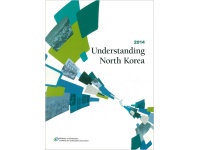- 소개
2014 북한이해를 영문판으로 번역하였습니다.
- 목차
CONTENTS
I. How should we view North Korea?
Section 1. Nature of the Northern Regime 11
Section 2. North Korea’s Dilemma 18
Ⅱ. Political System and Governing Principles
Section 1. History of the North Korean Regime and Establishment of its Political System 25
1. Soviet Occupation and Establishment of the North Korean Regime 25
2. Establishment of North Korea’s Political System and its Characteristics 28
Section 2. Formation of Governing Ideology and its Changing Nature 36
1. Juche Ideology 37
2. Songun Ideology 42
3. Kimilsungism-Kimjongilism 46
Section 3. Power Structure and Form of Government 49
1. Power structure 49
2. Workers’Party of Korea 55
3. Central Institutions 71
Section 4. Hereditary Succession of Power and the Kim Jong-un Regime 80
1. History of Hereditary Power Succession 80
2. Establishment and Stabilization of the Kim Jong-un Regime 86
Ⅲ. External Policies and Relations
Section 1. Goals and Directions of Foreign Policies 97
1. Basic Ideas and Goals of Foreign Policy 97
2. Policy Directions 99
3. North Korea’s Foreign Policy-making Structure 102
Section 2. Changes in Foreign Policy 105
1. Foreign Policy during the Cold War Era 105
2. Foreign Policy after the Cold War Era 111
Section 3. Foreign Relations 1171. US-North Korea Relations 117
2. China-North Korea Relations 127
3. Japan-North Korea Relations 132
4. Russia-North Korea Relations 137
5. Relations with the EU and Other Nations 141
Ⅳ. Military Strategy and Capacity
Section 1. Characteristics and Functions 153
1. Establishment of the KPA 153
2. Nature and Status 155
3. Functions and Characteristics 156
Section 2. Military Policy and Strategy 160
1. Basic Objective 160
2. Military Strategy 163
Section 3. Structure and Institutions 168
1. Military Structure 168
2. Military Institutions 173
Section 4. Military Capacity 179
1. Standing Forces and Equipment 179
2. Reserve Forces 185
3. Development of Nuclear and Other Strategic Weapons 187
Section 5. Military Relations and Provocations against the South 194
1. External Military Relationship 194
2. North Korea’s Provocations against the South 199
Ⅴ. Economic Structure and Policy
Section 1. Characteristics of Economic System and Basic Economic Policy 217
1. Basic Characteristics of Economic System 217
2. Basic Economic Policy 225
3. Establishment and Implementation of Economic Plans 234
Section 2. Economic Status by Sector 238
1. Macroeconomic Status and Tasks 238
2. Economic Status and Tasks by Sector 244
Section 3. Changes in Economic Policy and Outlook for Reform and Opening 259
1. Utilization and Control of Markets 259
2. Limited Opening 268
3. Prospects and Tasks for Reform and Opening 274
Ⅵ. Education and Culture
Section 1. Education System and School Life 281
1. Education Policy and School System 281
2. Educational Curriculum and Methods 299
3. School Life 308
Section 2. Literary Art Policy and Current Status 314
1. Literary Art Policy 314
2. Current Status of Literature and Art 321
Section 3. The Media and its Functions 334
1. Newspapers 335
2. Broadcasting 340
VII Society and Life
Section 1. Class Structure 349
1. Social Classes 349
2. Social Mobility and Class Structure 353
Section 2. Value System and Everyday Life 356
1. North Korean Citizens’Values 356
2. Daily Life and Life Cycle 362
3. Organizational Life 366
4. Clothing, Food, and Housing 373
5. Leisure and Holidays 380
Section 3. Religion in North Korea 386
1. View on Religion 386
2. Actual Conditions of Religious Beliefs 388
Section 4. Deviations and Social Control 391
1. Social Deviation and Crime committed by North Koreans 391
2. Social Control 398
Section 5. Human Rights in North Korea 404
1. Violation of Civic and Political Rights 405
2. Violation of Economic, Social, and Cultural Rights 410
3. Response to Criticism on Human Rights 413

No comments:
Post a Comment